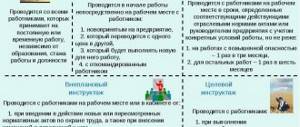What are safe working conditions and how to correctly interpret this term? People don’t often ask this question, since there are few reasons for its occurrence: someone may be interested in how safe the working conditions are at their workplace, someone is affected by the financial side or compensation, the third category may be looking for ways to resolve disputes with the employer, etc. etc. It doesn’t matter what reason brought the reader to this site - all the necessary information on this issue is collected here.
What are safe working conditions?
The official wording is as follows: “Safe working conditions are those in which the working personnel are not exposed to production risks or the level of exposure to production factors does not exceed established standards.”
Safe working conditions - what is it?
What does it mean? This wording means that the employee, in the course of his work activities, is guaranteed not to be exposed to the threat of physical injury or harm to health. As an example, consider the following situation. Typically, a workplace consists of a table, a chair (chair) and a computer (system unit, monitor, input/output devices). With proper space planning, as well as an acceptable level of radiation from operating equipment, no harm to health can be caused. But if there are bare wires in the room (from an extension cord or open wiring), then the fact that there is a threat to life or health is obvious. Regulatory authorities, when checking, have a legal basis for drawing up an act. An employee has the right to file a complaint against the employer. Dangerous conditions are considered to be any deviations from the prescribed standards.
Safety first. Employees are required to wear protective devices
Third class
Harmful working conditions (class 3) are working conditions under which the levels of exposure to harmful and (or) hazardous production factors exceed the levels established by the standards (hygienic standards) of working conditions, including:
- Subclass 3.1
Harmful working conditions of the 1st degree - working conditions under which the employee is exposed to harmful and (or) dangerous production factors, after exposure to which the altered functional state of the employee’s body is restored, as a rule, after a longer period than before the start of the next working day (shift), cessation of exposure to these factors, and the risk of health damage increases.
- Subclass 3.2
Harmful working conditions of the 2nd degree - working conditions under which the employee is exposed to harmful and (or) dangerous production factors, the levels of exposure of which can cause persistent functional changes in the employee’s body, leading to the emergence and development of initial forms of occupational diseases or occupational diseases of mild severity (without loss of professional ability) arising after prolonged exposure (15 years or more).
- Subclass 3.3
Harmful working conditions of the 3rd degree - working conditions under which the employee is exposed to harmful and (or) dangerous production factors, the levels of exposure of which can cause persistent functional changes in the employee’s body, leading to the appearance and development of occupational diseases of mild and moderate severity (with loss of professional ability to work) during the period of working activity.
- Subclass 3.4
Harmful working conditions of the 4th degree - working conditions under which the employee is exposed to harmful and (or) dangerous production factors, the levels of exposure of which can lead to the emergence and development of severe forms of occupational diseases (with loss of general ability to work) during the period of work.
Organization of safe working conditions and employer responsibilities
Safe working conditions are one of the main responsibilities of an employer. The impact of operating devices is limited to the established level. The proper amount is specified in the standards. Maximum permissible EMF standards:
Labor protection: what is it, concept, definition
Electric field strength:
- range 5 Hz - 2 kHz, E1: 25 V/m;
- range 2 kHz - 400 kHz, E2: 2.5 V/m.
Magnetic Flux Density:
- range 5 Hz - 2 kHz, B1: 250 nT;
- range 2 kHz - 400 kHz, B2: 25 nT.
There is a legislative system that controls the protection of workers' health. This considers the significance of the level of risk to which an employee is exposed in the course of his activities.
Note! Occupational safety and health is classified according to the level of hazard that threatens the health of the worker.
To eliminate the likelihood of injury and illness, a number of measures must be taken. The level of health hazard is determined by expertise. The presence of any minimal deviations may mean for an entrepreneur or organization of proceedings with regulatory authorities. How can the definition of “harmless” be understood? The concept of “safety” excludes any, even the most insignificant, factors affecting the health of an employee.
Control over the state of workplaces is carried out by regulatory structures
In legal practice, there is a well-known case in which the performer’s workplace was under a direct flow of cold air created by the ventilation system. After receiving a request from a worker to change his workplace, management took no action, and the employee was hospitalized with a severe cold. As a result, the employee filed a lawsuit and demanded compensation, which he was able to receive after a short trial.
Note! Also, special attention should be paid to fire-fighting equipment. Even if the employee's main activity is as a mechanic, the employer must ensure safety on all counts. By law, any employee has the right to file a complaint, but factual evidence determines victory in the case.
Where to train OT specialists
Where can an OT specialist get training? Training is provided by specially accredited organizations. This could be, in particular, the Institute of Occupational Health and Industrial Safety, other institutions, the Center for Occupational Health and Industrial Safety.
All employees must undergo special occupational safety training in the first month upon entry to work within the scope of the duties of the position. The following categories with at least five years of experience are exempt from this training:
- employees with the qualification of an engineer (specialist) in the safety of technological processes and production or in occupational safety;
- employees of federal and regional authorities in the field of control and supervision of occupational safety;
- teachers teaching the relevant discipline with experience without a break for five years.
The named categories have the right not to undergo training and testing of existing knowledge for one year after hiring. Further training occurs as needed, but at least once every three years. Such training for an OT specialist can be carried out by:
- training organization;
- employer if it has a commission that checks knowledge of occupational safety requirements.
However, the Ministry of Labor of the Russian Federation, in Letter No. 15-2/B-5568 dated December 29, 2015, expressed the opinion that it is necessary to train specialists in training organizations. Also, this requirement must be adhered to in order to avoid possible risks of prosecution under Parts 3, 5 of Art. 5.27.1 Code of Administrative Offenses of the Russian Federation.
You can get detailed information from, for example, the forum on labor protection and industrial safety, as well as the official website of the Ministry of Labor of the Russian Federation.
How to find out the level of danger
Special working conditions: what are they?
In total, there are 4 types of conditions:
- Optimal.
- Acceptable.
- Harmful (divided into harmful degrees 1, 2, 3, and 4).
- Dangerous.
Important! Safe working conditions are characterized by the absence of any threats to the health or life of the worker. The Legal Code states that an employee has the right to move to another department or change workplace in order to ensure safety at the enterprise.
In total there are 4 degrees of working conditions
The working environment is assessed by the following parameters:
- Physical - level of humidity and temperature in the room, presence of dust in the air, air currents, level of vibration and noise, level of illumination, electromagnetic radiation.
- Chemical - alkalis, chemicals, acids or paints and varnishes.
- Biological - infections, microorganisms and spores.
- Loads (dynamic or static) - body position during working hours, turns and tilts of the body, weight of objects lifted, frequency of movements and distance.
- The intensity of work activity is the presence of similar movements repeated many times over a long period of time, as well as mental or emotional stress.
Note! These criteria will help determine the level of danger at work, and then lawyers will help you draw up competent acts or statements, if necessary.
Benefits for hazardous working conditions
Working conditions in the workplace: what is it?
According to labor safety conditions, an employee can count on benefits if he encounters harmful conditions at the enterprise. The employee has the right to demand additional pay and/or benefits commensurate with the level of danger. Compensations are calculated in accordance with the level of harm caused to health and are as follows:
- Early retirement.
- Financial compensation, salary increase.
- Additional paid leave (annually).
- Reduced working hours (hours per week).
The employer is required to provide compensation to workers who work in harmful or dangerous conditions.
Every employee should demand appropriate compensation
Ergonomic requirements for workplace organization
Organizing a workplace involves proper planning and provision of the premises with the equipment necessary for the employee’s work. All workplaces of office employees have standards, just like workplaces of chemists, doctors, builders, etc.
General ergonomic requirements for the place where the subject will work are given in the following standards:
- GOST 12/2/032-78. This GOST assumes ergonomic requirements for the seats of those employees whose work duties are performed in a sitting position;
- GOST 12/2/033-78. Contains ergonomic requirements for positions of workers performing standing duties.
These requirements include the following:
- the arrangement of the workplace must take into account the anthropometric, physical and psychological characteristics of employees, as well as the direction of production activities;
- all objects necessary for the employee in the process of professional activity must be within reach;
- those objects that are often used by the employee must be within easy reach, etc.
These standards do not set out the requirements for the workplaces of drivers, as well as other workers whose work is not stationary. Also included in these categories of the employed population are military personnel and persons undergoing practical training.
Legislation governing the issue
The employer must follow all legal requirements. Detailed information can be found in the Labor Code. All questions regarding the terms of the contract and working conditions with employees are detailed here. Responsibilities on the part of the customer and the contractor.
There is also a chapter that discusses working conditions and their classification in detail. It is called “Article 14. Classification of working conditions”. Here are 9 points that cover all terms. In the next article numbered “15” you can find information about the results of the check.
Every specialist must know his rights
This information is sufficient to determine whether there is a threat to the health of workers at the enterprise. If the situation is truly dangerous to the health of workers, then proceedings should be initiated in accordance with the legal code. It is also recommended that you carefully read the Labor Code before taking direct action.








